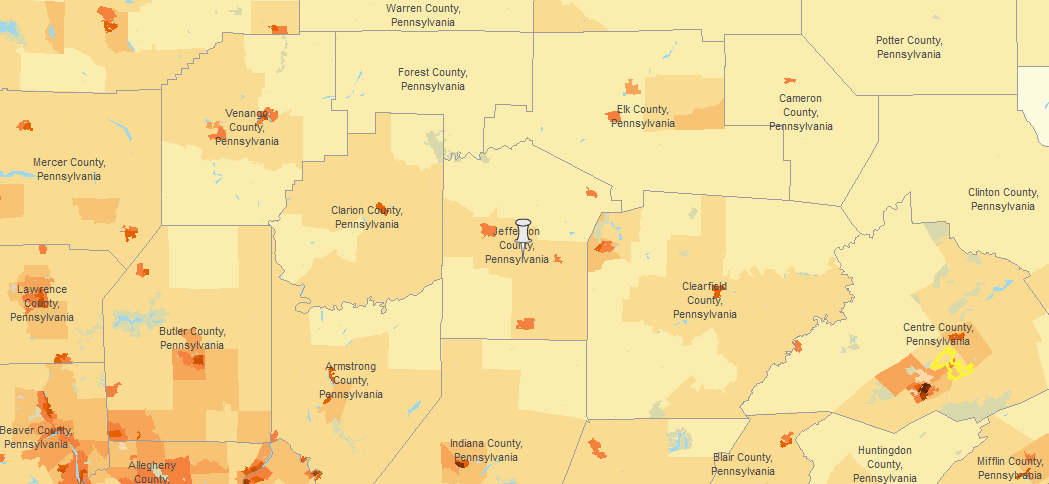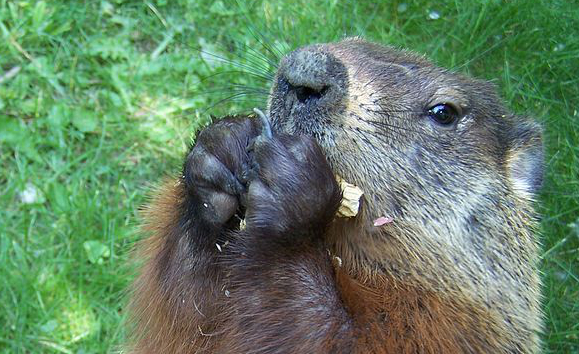In the United States, a German belief about the badger (applied in Switzerland to the wolf) has been transferred to the woodchuck, better known as the groundhog: on Candlemas he breaks his hibernation in order to observe the weather; if he can see his shadow he returns to his slumbers for six weeks, but if it rains he stays up and about, since winter will soon be over. This has earned Candlemas the name of ‘Groundhog Day’. In Quarryville, Lancaster County, Pa., a Slumbering Groundhog Lodge was formed, whose members, wearing silk hats and carrying canes, went out in search of a groundhog burrow; on finding one they watched its inhabitant’s conduct and reported back. Of twenty observations recorded, eight prognostications proved true, seven false, and five were indeterminate. The ritual is now carried on at Punxsutawney, Pa., where the weather prophet has been named Punxsutawney Phil. (The Oxford Companion to the Year)
Every February Second, people across Pennsylvania and the world look to a famous rodent to answer the question—when will spring come?
For over 120 years, Punxsutawney Phil Soweby (Punxsutawney Phil for short) has offered his predictions, based on whether he sees his shadow (more winter) or not (an early spring).
The first official Groundhog Day celebration took place in 1887 and Phil has gone on to star in a blockbuster film, dominate the early February news cycle, and even appear on Oprah. (He also has his own Beanie Baby and his own flower.)
In addition to weather predictions, Phil also loves data, and while people think he is hibernating, he is actually conducting demographic analysis. As a Social Explorer subscriber, he used the site’s mapping and reporting tools to look at the composition of his hometown.
Punxsutawney, PA, located outside of Pittsburgh, is part of Jefferson County. Examining Census data from 1890, Phil learned that the population was 44,405 around the time of his first predictions. While the rest of the nation was becoming more urban, Jefferson County remained more rural with only one eighth of the population living in places with 2,500 people or more (compared to nearly half statewide and more than a third in the US).
Many Jefferson residents worked in the farming industry. Back then, there were 3.2 families for every farm in Jefferson County — higher than the rest of the state with 5.0 families per farm.
Less than three decades after the Civil War, the county (located in a northern state) was 99.9 percent white, which was a little higher than statewide (97.9 percent) and also higher than nationwide 87.8 percent. (The Census also noted that there was one Chinese resident of Jefferson County in 1890.)
Groundhog Day was originally called Candlemas, a day that Germans said the hibernating groundhog took a break from slumbering to check the weather. (According to the Oxford Companion to the Year.) If the creature sees its shadow, and is frightened, winter will hold on and hibernating will continue, but if not, the groundhog will stay awake and spring will come early. Back in 1890, there were 703 Germans living in Jefferson County (representing 1.6 percent of the county population and 11.3 percent of the foreign born), making Germany the fourth most common foreign born place of birth behind England, Scotland, and Austria. Groundhog Day is also said to be Celtic in its roots, so perhaps the 623 Irish residents (representing 1.4 percent of the county population and 10.1 percent of the foreign born) helped to establish the tradition in Pennsylvania.
Looking to today’s numbers, Phil was astonished to learn from the 2010 Census that Jefferson County has just 795 more people than it did 120 years ago. While Jefferson grew by 1.8 percent, the state grew by 141.6 percent and the nation grew by 393.0 percent.

Phil dug deeper. The 2008-10 American Community Survey data reveal that the once-prominent farming industry had shrunk considerably. (Because it is a small group, “agriculture” is now grouped with other industries including forestry, fishing and hunting, and mining.) While Jefferson residents are more likely to work in the industry than other Pennsylvanians, that share represents just 4.4 percent of the employed civilian workforce.
According to the Census, Jefferson is still predominately white (98.3 percent), while the rest of the state and nation have become somewhat more diverse (81.9 percent white in Pennsylvania and 72.4 percent nationwide). Today there are 24 Chinese residents (out of a total of 92 Asian residents).
As Phil rises from his burrow this February second, he will survey the shadows with new insight into his community and audience. To learn more about Punxsutawney Phil’s hometown burrow (and your own borough), please visit our mapping and reporting tools.




Recent Comments
There are currently no comments.